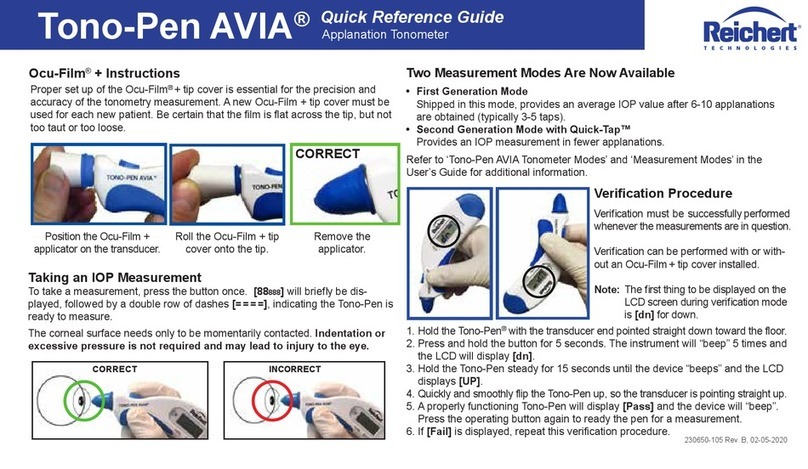
Reichert Technologies
Analytical Instruments
3362 Walden Ave
Depew, NY 14043
USA
Toll Free: 888-849-8955
Phone: 716-686-4500
www.reichertai.com
AMETEK GmbH
Business Unit Reichert
Carl-von-Linde-Strasse 42
85716 Unterschleissheim
Munich, Germany
Tel: +49 (89) 315 8911 0
Fax: +49 (89) 315 891 99
ISO 13485 Certied
ISO 9001 Certied
13940030-101 REV A 9/2015
SPECIFICATIONS:
Catalog 13940030, 13940031
Reading Scales -
DOT3 BP = Boiling point
DOT4 BP = Boiling point
EG FP = Freeze point, ethylene glycol antifreeze
EG % = Percent ethylene glycol antifreeze by volume
DEF % = DEF/AdBlueTM,Diesel exhaust uid
WW FP = Freeze point, (methanol) windshield washer uid
SG = Specic gravity, battery acid
Reading Ranges, Accuracy -
DOT3 BP = 250°F - 500°F / 121°C - 260°C
DOT4 BP = 257°F - 527°F / 125°C - 275°C
EG FP = 32° thru -70°F / 0° thru -57°C, ± 0.5°F/± 0.3°C
EG % = 0 thru 95 percent, ± 0.2%
DEF % = 0 - 50% w/w (weight), ± 0.1%
WW FP = 32° thru -65°F / 0° thru -54°C, ± 2°F/± 1°C
SG = 1.000 - 1.463 SG, ± 0.003 SG
Calibration - Distilled Water
Automatic Temperature Compensation
The built in temperature compensation is based on
the temperature coefcients that have been calculated
for the individual solutions offered in this instrument.
Prism - Glass
Illumination - 589nm LED
Dimensions - 54 x 27 x 100 mm / 2.13 x 1.06 x 3.9 inches
Power - 2 AAA (LR3) Batteries, included.
Battery life - 10,000 readings, Auto Off Sleep Mode.
Ratings - IP65 Dustproof/Water Resistant, CE, RoHS,
and WEEE compliant.
Warranty - One year against manufacturing defects. Evidence of
tampering voids warranty.
ERROR CODES:
Err01 - No sample present. Add sample.
Err02 - Inadequate sample. Add additional sample.
Err03 - Sample exceeds the refractive index reading range.
Err04 - Sample temperature has not equilibrated. Allow more time for
temperature equilibration.
Err05 - Excessive ambient light. Cover sample well when reading.
Err06 - Excessive ambient light. Cover sample well when reading.
Err07 - Positive calibration error. Re-calibrate with distilled water.
Err08 - Negative calibration error. Re-calibrate with distilled water.
Err09 - Poor sample condition. Sample may not be able to be read.
Err10 - Sample type may not be able to be read.
Err12 - Index of sample is out of range of instrument.
Err5X - For any errors in this series contact Reichert Analytical
Instruments for technical assistance.
DRY AND WET BOILING POINTS:
The Society of Automotive Engineers (SAE), Department of
Transportation (DOT) and the International Standards Organization
have established dry and wet boiling point specications for brake
uid. The dry and wet boiling points for the brake uid classes are:
Fluid Type Dry Boil Point Wet Boil Point
DOT 3 401°F/205°C 284°F/140°C
DOT 4 446°F/230°C 311°F/155°C
The “dry” and “wet” boiling points indicated in the above table are
intended to be used as a guide to judge the condition of the uid.
New uid must meet the “dry” specication. As the service life of
brake uid increases, the boiling point will approach the “wet” point.
WHEN TO CHANGE BRAKE FLUID:
Many motor vehicle manufacturers recommend checking brake uid
every 12 months, or changing uid every 24 months. The amount of
moisture that brake uid absorbs depends on a number of factors
including the type of uid, humidity, type of brake hoses, condition of
the seals and mileage. Brake uid will absorb 1% or more moisture
per year of service life. A two year old vehicle will have 2 to 3% water
in the brake uid. 3% water reduces the boiling point of DOT 3 brake
uid by approximately 175°F (97°C). 3% water in DOT 4 brake uid
reduces the boiling point by 162°F (90°C).
Generally, the type of driving should inuence when to change
brake uid. If the vehicle is used for towing, is driven in mountainous
regions, or has an ABS system it would be best to change the uid
sooner. All vehicles should have the brake uid changed when the
water exceeds the minimum wet boil point. Motor vehicle manufac-
turers may recommend brake uid changes at lower water content/
higher boiling point than shown on the chart. OEM service recom-
mendations should be followed.
ANTIFREEZE:
Using this temperature compensated instrument to test freeze point
protection, provides results that are precise to ±1°F(±0.6°C) when
reading a 50 % (vol) aqueous solution of ethylene glycol based
antifreeze. By comparison, a hydrometer is only precise to
±8°F(±4.4°C).
Note, that it is recommended that the vehicle manufacturers
recommendations be followed concerning
concentration for best heat transfer and component protection
of the cooling system.
DIESEL EXHAUST FLUID:
Measurement of DEF/AdBlue™ indicates the percent urea content in
diesel exhaust uid. The instrument provides results that are precise
to ± 0.1% by weight. ISO 22241 requires diesel exhaust uid to be
between 31.8% and 33.2% concentration by weight.
BRAKE FLUID:
WINDSHIELD WASHER FLUID:
The windshield washer uid scale in this instrument is designed to
measure the freeze point of methanol based washer uids
accurately to ± 2°F (±1°C).
European produced vehicles often arrive with windshield washer
uid that is ethanol based. Due to the differences between ethanol
and methanol, this instrument will not display an accurate value for
ethanol based washer uids.
Brake
Fluid Type
Water
Content
Boiling
Point, °F
Boiling
Point, °C
Condition
DOT3 < 2%, Dry > 356° F > 180° C OK
> 3%, Wet < 320° F < 160° C Change
DOT4 < 3%, Dry > 356° F > 180° C OK
> 4%, Wet < 310° F < 155° C Change
The change levels indicated on this chart are guidelines only.




















